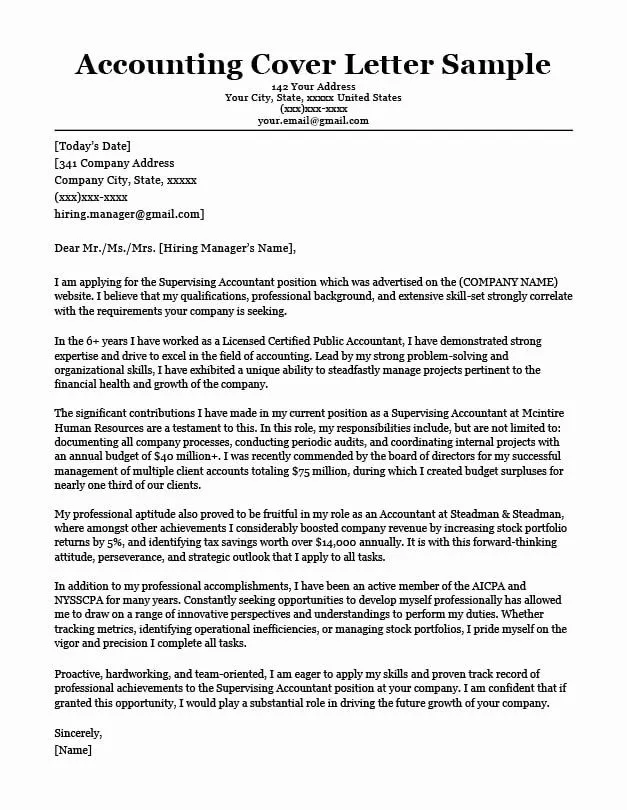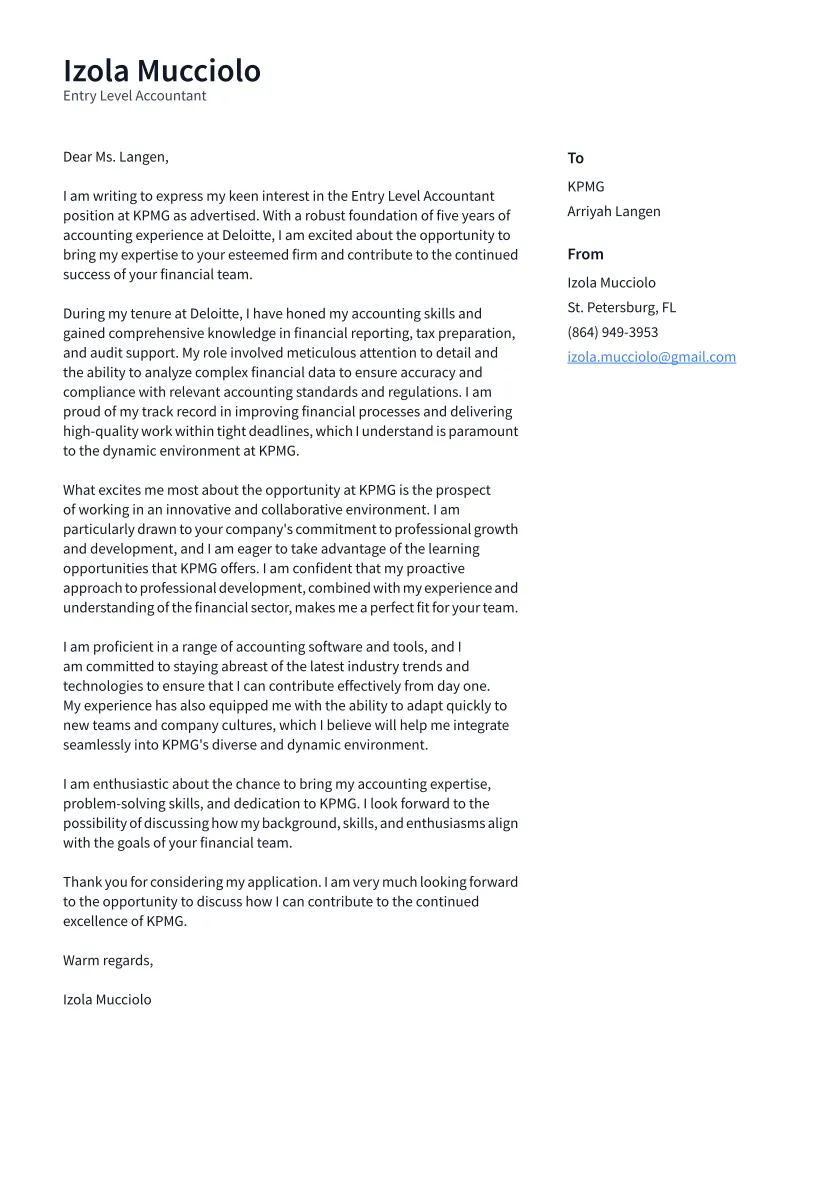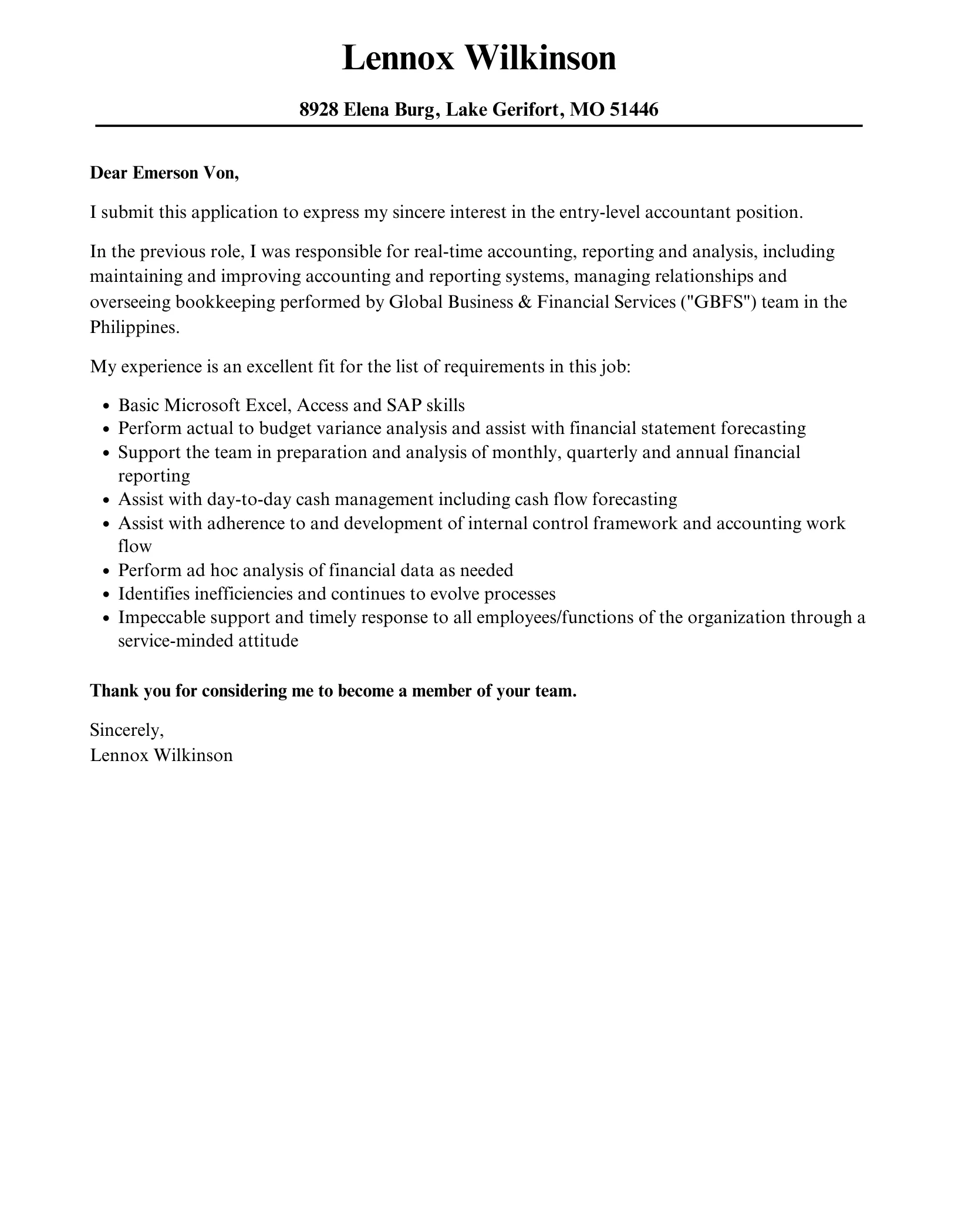Crafting Your Accountant Cover Letter The Foundation
Your accountant cover letter is your first opportunity to make a strong impression on potential employers. It serves as a critical introduction, providing a snapshot of your skills, experience, and personality. For entry-level accountants, this letter is especially important, as it helps you differentiate yourself from other candidates. The foundation of a compelling cover letter begins with understanding its purpose. It’s not just a repetition of your resume; rather, it’s a chance to elaborate on your qualifications, highlight relevant experiences, and express your enthusiasm for the position and the company. A well-crafted letter should clearly articulate why you are a suitable candidate and what you can bring to the role. Remember, the goal is to secure an interview, and your cover letter is the first step toward achieving that objective.
Understanding the Entry-Level Accountant Role
Before writing your cover letter, thoroughly understand the entry-level accountant role. Research typical responsibilities, required skills, and the company’s expectations. This understanding will allow you to tailor your letter effectively, demonstrating that you possess the qualities needed to succeed. Entry-level positions often involve tasks such as data entry, account reconciliation, financial statement preparation, and assisting with audits. Familiarize yourself with these tasks and highlight any relevant experience, even if it comes from internships, volunteer work, or academic projects. Furthermore, consider the specific industry of the company you’re applying to. Different industries may have unique accounting requirements and terminology, so tailor your language and examples accordingly. Showing that you understand the role and the company’s context significantly boosts your chances of making a positive impression.
Highlighting Relevant Skills and Experience

Even with limited professional experience, you likely possess skills and experiences that are relevant to an accountant position. Think about your coursework, projects, and any extracurricular activities that demonstrate your abilities. Focus on skills such as attention to detail, analytical thinking, problem-solving, and proficiency in accounting software. Provide specific examples of how you’ve used these skills in the past. For instance, if you’ve balanced a budget for a student organization, describe the process and the results. If you’ve used Excel to analyze data, mention the types of formulas and functions you used. When highlighting experience, quantify your achievements whenever possible. For example, instead of saying ‘Assisted with accounts payable’, state ‘Processed an average of 50 invoices per week, ensuring accuracy and timely payments.’ Use keywords from the job description to ensure your letter aligns with the employer’s requirements and to pass applicant tracking systems (ATS).
Education and Certifications Showcasing Your Credentials
Your educational background and any certifications are crucial for an entry-level accountant position. Clearly state your degree (e.g., Bachelor of Science in Accounting) and the name of the institution. If you have a high GPA, consider including it, especially if it’s impressive. Mention any relevant coursework, such as financial accounting, auditing, or taxation. Highlight any certifications you hold or are pursuing, such as a Certified Public Accountant (CPA) or Certified Management Accountant (CMA). If you’re studying for these certifications, indicate your progress. Even if you’re just starting, mentioning your intent to pursue further professional development demonstrates your commitment to the field. Detail any honors, awards, or scholarships you’ve received, as these achievements showcase your dedication and academic excellence. Make sure to list any relevant software you’ve learnt through education.
Quantifying Achievements Making an Impact
Quantifying your achievements is a powerful way to demonstrate your capabilities and make a strong impression. Instead of simply stating your responsibilities, provide concrete examples of your accomplishments, backed by data. For example, if you improved a process, quantify the improvement by stating the percentage of time saved or the reduction in errors. If you helped to reconcile accounts, mention the number of accounts you reconciled or the dollar amount involved. Using numbers not only shows that you are results-oriented but also allows the employer to understand the scope of your contributions. Always frame your achievements in a way that aligns with the needs of the prospective employer. If the job description mentions the importance of accuracy, focus on how you’ve ensured accuracy in your previous experiences. The more specific and measurable your examples, the more persuasive your cover letter will be.
Tailoring Your Cover Letter Personalization is Key

Generic cover letters rarely succeed. Tailoring your letter to each specific job application is essential to demonstrate your genuine interest in the position and the company. Start by carefully reading the job description and identifying the key requirements and expectations. Then, customize your letter to address these points directly. Highlight the skills and experiences that are most relevant to the specific role. Show that you understand the company’s mission, values, and industry. Mention any specific projects or initiatives that align with their goals. Avoid using a one-size-fits-all approach. Research the hiring manager or the team you would be working with, if possible, and address the letter to a specific person. This personalization shows that you’ve taken the time to learn about the opportunity and are serious about joining the company. This is your opportunity to stand out from the crowd.
Researching the Company Demonstrating Interest
Thoroughly researching the company is a critical step in crafting an effective cover letter. Your research demonstrates your genuine interest and allows you to tailor your letter to align with the company’s values and goals. Start by visiting the company’s website and social media profiles. Learn about their products or services, their mission statement, their culture, and their recent news or achievements. Look for information about their current projects, clients, and any industry awards or recognition they’ve received. If possible, research the company’s competitors to understand their position in the market. Mention specific details in your cover letter that show you’ve done your homework. For example, you could mention a recent company initiative that aligns with your skills or a recent achievement that impressed you. This level of detail shows the hiring manager that you’re not just applying for a job, but that you’re genuinely interested in joining their team.
Formatting and Structure Presenting a Professional Image
The formatting and structure of your cover letter are just as important as its content. A well-formatted letter presents a professional image and makes it easier for the reader to quickly grasp your qualifications. Use a clear, easy-to-read font, such as Times New Roman or Arial, in a standard size (e.g., 11 or 12 points). Keep the letter concise, ideally within one page. Use a professional layout, with appropriate margins and spacing. Start with your contact information, followed by the date, the hiring manager’s name (if available), and the company’s address. Use clear headings and subheadings to organize your content and make it easy to scan. Break up large blocks of text into shorter paragraphs to improve readability. Proofread your letter carefully for any grammatical errors or typos. A polished and well-structured cover letter will make a positive first impression and show that you pay attention to detail.
Proofreading and Editing Ensuring Flawless Presentation

Proofreading and editing your cover letter is the final and most crucial step in the writing process. A single grammatical error or typo can undermine your credibility and leave a negative impression on the hiring manager. After completing your draft, set it aside for a few hours or even a day, then review it with fresh eyes. Check for spelling errors, grammatical mistakes, punctuation errors, and awkward phrasing. Read the letter aloud to catch any errors that you might miss when reading silently. Consider asking a friend, family member, or career advisor to proofread your letter as well. A second pair of eyes can often catch mistakes that you may have overlooked. Ensure that your letter is clear, concise, and easy to understand. Make sure the tone is professional and enthusiastic. A flawless cover letter demonstrates your attention to detail and your commitment to excellence, greatly increasing your chances of success.
Call to Action Encouraging the Next Step
Your cover letter should conclude with a strong call to action, encouraging the hiring manager to take the next step in the hiring process. Express your enthusiasm for the opportunity and reiterate your interest in the position and the company. Clearly state your availability for an interview and provide your contact information again. Thank the hiring manager for their time and consideration. Be confident and assertive, but avoid being overly aggressive. For example, you could write, ‘I am eager to learn more about this opportunity and discuss how my skills and experience can contribute to your team. I am available for an interview at your earliest convenience and can be reached at [your phone number] or [your email address]. Thank you for your time and consideration.’ A well-crafted call to action will leave a positive impression and increase your chances of moving forward in the job application process. This is your opportunity to make a final, positive impact.
